NASA says SpaceX has finished encapsulating its DART asteroid redirection spacecraft inside Falcon 9’s fairing and opened up its West Coast launch pad hangar to give VIPs and mission team members a tour of their rocket.
Measuring 70m (230ft) tall, 550 metric tons (1.2M lb) fully fueled, and capable of producing more than 775 tons (1.71M lbf) of thrust at liftoff, Falcon 9 remains on track to launch NASA’s Double Asteroid Redirection Test mission no earlier than 10:21 pm PST, Wednesday, November 23rd (06:21 UTC 24 Nov). While there are multiple conflicting reports of the spacecraft’s launch mass, it will likely weigh between 600 and 650 kg (1300-1450 lb) – a minuscule 0.1% of the rocket’s total mass at liftoff. In simpler terms, Falcon 9 launching DART is a bit like a semi-truck carrying a single piece of wood.
Nevertheless, just like that semi-truck scenario, it might not be the most efficient choice of vehicle but sometimes a one-size-fits-all rocket like Falcon 9 can make a lot of sense.
Notably, despite being outsized by at least a factor of 2-3, Falcon 9’s DART launch will ultimately cost NASA about $73M – about a quarter of the mission’s total ~$250M cost. Nominally headed to interplanetary space, there isn’t a smallsat launcher (i.e. Firefly Alpha, Relativity Terran-1, Virgin Orbit LauncherOne, ABL Space RS-1, etc.) currently in development that’s expected to be able to launch a ~600 kg payload onto the interplanetary trajectory Falcon 9 will send DART on. If there were, it might theoretically cost NASA just ~$20M to launch DART but it will also take years for any of the new small to midsize rockets that might have enough performance to establish a track record of reliability, meaning that NASA would have to accept significant risk for that potential discount.
It’s worth noting that based on several comments from executives indicating that a flight-proven Falcon 9 costs about $15-25M to launch, SpaceX could almost certainly charge NASA half as much to launch DART while still breaking even, with its routine reusability making the potential economic advantage of smaller rockets much murkier. Additionally, despite the potential to save another $30-50M, NASA is still likely saving at least $80-100 million by launching on a $73M Falcon 9 rocket rather than the United Launch Alliance’s (ULA) cheapest Atlas V offering, which NASA has paid around $150-175M for in recent years.
While SpaceX has technically launched two similarly tiny NASA payloads to very high orbits ~300,000 and ~900,000 km (150,000-600,000 mi) away from Earth in 2015 and 2018, as well as CEO Elon Musk’s Tesla Roadster on an Earth escape trajectory with Falcon Heavy, data from JPL recently confirmed that DART will be Falcon 9’s first truly interplanetary launch. After reaching a normal low Earth parking orbit, Falcon 9’s expendable upper stage will ultimately boost the small spacecraft free of Earth’s gravity, sending it into a heliocentric orbit that will eventually intersect with the binary Didymos-Dimorphos asteroid system.
As early as September 2022, DART will slam into asteroid moon Dimorphos while traveling a staggering 6.6 kilometers per second (4.1 mi/s) in an attempt to shift its orbit around the larger Didymos asteroid. In effect, NASA is using the asteroid system a bit like an isolated sandbox to (hopefully) exaggerate any effects. If successful, DART will prove that kinetic impactors offer a viable way to change the course of asteroids and comets, potentially paving the way for the creation of a true planetary defense program.





